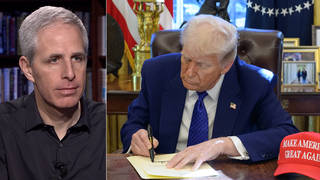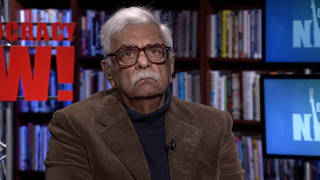
Related
Topics
Guests
- Walter HangPresident of Toxics Targeting, an environmental database firm in Ithaca, New York.
The New York-based Toxics Targeting went through the Department of Environmental Conservation’s own database of hazardous substances spills over the past thirty years. They found 270 cases documenting fires, explosions, wastewater spills, well contamination and ecological damage related to gas drilling. Many of the cases remain unresolved. The findings are contrary to repeated government assurances that existing natural gas well regulations are sufficient to safeguard the environment and public health. The state is considering allowing for gas drilling in the Marcellus Shale watershed, the source of drinking water for 15 million people, including nine million New Yorkers. [includes rush transcript]
Transcript
AMY GOODMAN: We begin today with the latest developments on gas drilling in the Marcellus Shale watershed, potentially the largest natural gas reserve in the country and the source of drinking water for 15 million people, including nine million New Yorkers. On Monday, an environmental research group released government data revealing New York state regulation of natural gas wells has been, quote, “woefully insufficient for decades.”
The upstate New York-based Toxics Targeting went through the Department of Environmental Conservation’s own database of hazardous substances spills over the last thirty years. They found 270 cases documenting fires, explosions, wastewater spills, well contamination and ecological damage related to gas drilling. Many of the cases remain unresolved.
The findings are contrary to repeated government assurances that existing natural gas well regulations are sufficient to safeguard the environment and public health.
Well, the New York Department of Environmental Conservation didn’t respond to our requests for comment. They told the Ithaca Journal, however, that spills from the oil and gas industry constituted a very small proportion of the total number of spills recorded in the past three decades, adding that such accidents are rare.
For more on this, I’m joined here in our firehouse studio by Walter Hang, the president of Toxics Targeting.
Welcome to Democracy Now!
WALTER HANG: Thank you for inviting me.
AMY GOODMAN: Now, for a national audience, let alone a New York audience, I think most people have never heard of what Marcellus Shale is.
WALTER HANG: That’s right. It’s this giant rock formation, very deep underground. It’s about a mile deep, and it stretches from just north of Syracuse, New York, all the way to Tennessee. This is very thick impermeable rock, but it’s got gas inside these tiny little pores.
So, up until now, there really hasn’t been any effective way to get the gas out of the rock, because it’s so deep and because it’s so impermeable. But now there’s a new technology. It’s called “slick water hydrofracking,” and it involves horizontal drilling. So they drill down, and then they drill through the rock layer, and then they force incredibly highly pressurized water that’s got a lot of additives, and this fractures the rock. This then lets the gas out, and then they retrieve it.
Unfortunately, it requires tremendous amounts of water, and it’s incredibly polluting. So the water that comes out of the ground has toxic chemicals, petroleum compounds, and it’s actually radioactive. So up until —-
AMY GOODMAN: Wait, wait, wait, wait. “It’s actually radioactive.” What do you mean?
WALTER HANG: Believe it or not, when the water gets drawn out of this deep rock formation, there’s radon, there’s uranium, so the water that comes out is radioactive, as well as toxic-contaminated. So, one of the key problems is, what do you do with all this wastewater? And that’s the issue that we investigated.
So, New York has had natural gas drilling for almost 200 years, and everyone at the state government and industry level has said, “We’ve never had a problem. We’ve been drilling. It’s reliable technology. No problems.” When we looked at the State of New York’s own data, however, we found, again, fires, explosions, huge uncontrolled releases of wastewater that went into people’s drinking water, went into wetlands, streams. Many of these problems haven’t been cleaned up, even after decades.
Arguably the worst case was in Freedom, New York. Someone named Dale Fox was drilling a vertical well, and he hit a gas pocket. The natural gas was incredibly pressurized. It came blasting out of this 2,000-foot-deep hole. It picked up petroleum on the way up. It shot out of the hole. The wind blew this incredibly flammable explosive mixture onto the drill rig. They had to shut off the drill rig. Then they couldn’t kill the well. They couldn’t stop the gas from exploding out of the well. It got in a rock fracture, and in a matter of minutes it went 8,000 feet. It contaminated twelve homes, that were evacuated. It polluted drinking water wells. It polluted drainage ditches, ponds. And it came up in this farmer’s barn, where his dairy herd was. Believe it or not, more than ten years after that release, the water is still undrinkable.
And in the New York City reservoir system, the only protection would be that you can’t drill a well within 300 feet, compared to this problem which went 8,000 feet. So these regulations that have been proposed by the Governor, David Paterson, are totally inadequate. And again, they’re based on this false assumption that the existing regulations are adequate. And that’s how come I’ve written to him to say, “Withdraw this proposal, look at the problems that your own Department of Environmental Conservation has documented, and come back when you have something that’s actually going to assure that this drilling can be done safely and without harming public health.”
AMY GOODMAN: I have seen images that you’ve posted on your website of water lighting up, being flammable, light -— water catching fire.
WALTER HANG: This is just incredible. About a year ago — actually, a little bit more than a year ago, basically, a Vietnam vet living in Candor, New York had discovered that, even though he had lived in the same house since 1962, his water started to release gas, and he discovered that you could light it. And he was immediately east of an area where they had begun drilling. So, last January, he complained to the Department of Environmental Conservation. He said, “Hey, my water is flammable. I can light it.”
AMY GOODMAN: Instead of the flame going out, it lights up.
WALTER HANG: It lights up. I mean, you will literally turn on the water, the water will start coming out of the faucet, and then it will like burp gas. And if you hold a match to it, it literally ignites.
So the incredibly shameful thing is that the Department of Environmental Conservation did not even come to look at this situation. They simply told this disabled vet, Mr. Mayer, “Don’t drink the water.” And that was it. And the key thing is, they said this reported problem was administratively closed out, and it met the applicable cleanup standards. They didn’t do anything, but they said it met the cleanup standards. There are hundreds of similar kinds of problems where the Division of Mineral Resources in the state of New York has said, “Yep, that problem is taken care of,” even though it appears that they did inadequate cleanup. And some of these problems, again, have been going on for decades.
AMY GOODMAN: When you describe, for example, the herd of cows, when you describe all the houses that had to be evacuated, what happens to these families? What happened to the cows? What happened to the water? You said that it was permanently polluted?
WALTER HANG: The day of the gas release, I asked one of the people whose wells got contaminated — I said, “How did you know that your water got polluted?” He said, “It turned black.” In other words, when the gas went through this rock fracture and came up this person’s well, it just blasted out the pollution in the water. You could see it was oily. It had all kinds of contamination. And he has never been able to drink it.
So, eventually the gas petered out. They hit the gas pocket. The gas was released. It came up in the ground. It was just jetting out all over this area through this fractured rock. Eventually, the gas was released, but the residual pollution has never been cleaned up.
And that’s the problem all over New York. There are these problems where oil has been spilled, gas is released in uncontrolled fashion, and the state Department of Environmental Conservation has simply failed to clean up these problems. And that’s how come we should not go forward with Marcellus gas horizontal, high-volume fracking, until we have an adequate regulatory program.
AMY GOODMAN: Who benefits from it?
WALTER HANG: The benefit, if we do it well, is that the natural resources will be protected, communities will be protected, people’s drinking water won’t be impacted — notably, the people in the City of New York, who drink water from the Catskills. There are these huge reservoirs that are above the Marcellus Shale.
If we don’t do it well, then many of the biggest companies in the planet are going to save money — Chesapeake, Fortuna, Talisman, Hess. These are giant corporations. They are chomping at the bit to come to New York and to drill for this giant reserve of gas.
AMY GOODMAN: The largest possibly in the country?
WALTER HANG: That’s right. The problem is it is very difficult to get out of this deep rock formation. Usually if you drill into a gas pocket, the gas just comes right back up. But this requires this incredibly polluting hydrofracking, where they pump this liquid under tremendous pressure into the rock, and it just explodes out, maybe as far as 3,000 feet, shattering the rock. And then sand gets injected into the little fractures, and they draw the gas out.
AMY GOODMAN: What happens to the water, for example, in New York, where there are millions of people, obviously, who rely on the reservoirs upstate?
WALTER HANG: Well, right now there are almost no natural gas wells in the Catskills region. Literally, a handful. But that area does have Marcellus Shale. So if they begin to drill in that area, and if they cause the same kinds of uncontrolled pollution problems that other areas of New York have experienced — notably, western New York — then the drinking water could be impacted. And once these problems develop, they’re very difficult to clean up.
AMY GOODMAN: And you have states all over this country, of course, that are in dire economic shape, and so they are going to turn to any way they can make money. Is New York in that situation? And what are you doing right now?
WALTER HANG: New York, unfortunately, in the Southern Tier, in the Finger Lakes region in western New York, is in dire economic straits. These communities are just desperate for jobs. And so, it sounds so good: we’re going to get this gas out, we’re going to make tons of money, communities are going to benefit, the state of New York is going to benefit. Governor David Paterson has basically made this Marcellus Shale effort the linchpin of his economic development plan.
The problem is he hasn’t answered those key questions. What happens when hundreds and hundreds of these hundred thousand ton trucks start pounding these structurally deficient bridges that have been neglected for decades into pieces? Who’s going to pay for that? What about the roadways that are going to get destroyed? What are we going to do with all of this toxic wastewater?
Believe it or not, they were actually dumping this natural gas drilling wastewater from a vertical well in little Cayuga Heights, New York, and it was passing through this sanitary wastewater treatment plant that was not designed, constructed or maintained in any way to take out the toxics. And it was passing through into southern Cayuga Lake, which is a nationally recognized impaired water body. It’s already been polluted for decades. And this added to the problems. And 30,000 people drink water from that area.
So we’re looking at an impending disaster, and that’s how come we’re going to now try to organize all these communities to say this has to be done properly.
AMY GOODMAN: There’s one public hearing today?
WALTER HANG: That’s right, in the City of New York. They’re going to talk about the threat to the reservoirs. And so, that’s how come I’m here in New York. I’m going to talk to the Department of Environmental Conservation about these concerns.
And I’ve posted at toxicstargeting.com the 270 profiles. People can look at them and see, are there any major problems in my community in the Marcellus Shale region of New York?
But then we’re going to have a coalition letter that people can sign onto and basically say, “Governor Paterson, we’re just not ready to go forward with Marcellus Shale drilling, until we get these regulations. Don’t do it. Withdraw this proposed supplemental generic environmental impact statement.”
AMY GOODMAN: We only have thirty seconds, but the significance of the New York watershed, freshwater, how it comes into the city, how unusual it is in this country?
WALTER HANG: It’s absolutely unique. You have these upland reservoirs, hundreds of miles away from the city, and the water flows completely under gravity through these giant tunnels. It’s so pure it doesn’t even need to be filtered. And so, this is a jewel. Any city in the world would give anything to have this water. That’s why it has to be safeguarded. It has to be protected. Once it’s polluted, then the city would have to treat that water at gargantuan cost. So Mayor Bloomberg and all the other city leaders have to unite with all the other New Yorkers who could be impacted by Marcellus Shale.
AMY GOODMAN: Walter Hang, thank you so much for being with us, president of Toxics Targeting, an environmental database firm in Ithaca, New York. The one hearing today is taking place at Stuyvesant High School?
WALTER HANG: Yes.
AMY GOODMAN: Today at 5:00?
WALTER HANG: 6:30, actually.
AMY GOODMAN: 6:30 in the evening. And we’ll let people know what comes of that.












Media Options